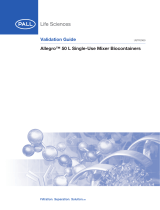
5
Allegro MicroSystems
955 Perimeter Road
Manchester, NH 03103-3353 U.S.A.
www.allegromicro.com
RELATED LINKS
The ACS37002 product datasheet is available for download on the Allegro website. In addition, several application notes and related
information is available. This information is listed in the table below.
Table 3: Related Documentation and Application Notes
Documentation Summary Location
ACS37002 Product datasheet defining common electrical
characteristics and performance characteristics
https://www.allegromicro.com/-/media/files/
datasheets/acs37002-datasheet.ashx
ACS37002 Purchasing Purchasing homepage https://www.allegromicro.com/en/products/
sense/current-sensor-ics/zero-to-fifty-amp-
integrated-conductor-sensor-ics/acs37002
An Effective Method for Characterizing
System Bandwidth in Complex Current Sensor
Applications
Application note describing methods used
by Allegro to measure and quantify system
bandwidth
https://allegromicro.com/en/insights-and-
innovations/technical-documents/hall-effect-
sensor-ic-publications/an-effective-method-for-
characterizing-system-bandwidth-an296169
DC and Transient Current Capability/Fuse
Characteristics of Surface Mount Current
Sensor ICs
DC and Transient Current Capability/Fuse
Characteristics of Surface Mount Current
Sensor ICs
https://www.allegromicro.com/en/Insights-and-
Innovations/Technical-Documents/Hall-Effect-
Sensor-IC-Publications/DC-and-Transient-
Current-Capability-Fuse-Characteristics.aspx
ACS37002 Gerber Files Schematic files containing demo board layers https://www.allegromicro.com/-/media/allegro/
allegromicro/files/gerber-files/asek37002_
gerber_files.ashx
High-Current Measurement with Allegro Current
Sensor IC and Ferromagnetic Core: Impact of
Eddy Currents
Application note focusing on the effects of
alternating current on current measurement
https://allegromicro.com/en/insights-and-
innovations/technical-documents/hall-effect-
sensor-ic-publications/an296162_a1367_
current-sensor-eddy-current-core
Secrets of Measuring Currents Above 50 Amps Application note regarding current measurement
greater than 50 A
https://allegromicro.com/en/insights-and-
innovations/technical-documents/hall-effect-
sensor-ic-publications/an296141-secrets-of-
measuring-currents-above-50-amps
Allegro Hall-Effect Sensor ICs Application note describing Hall-effect principles https://allegromicro.com/en/insights-and-
innovations/technical-documents/hall-effect-
sensor-ic-publications/allegro-hall-effect-sensor-
ics
Hall-Effect Current Sensing in Electric and
Hybrid Vehicles
Application note providing a greater
understanding of hybrid electric vehicles and the
contribution of Hall-effect sensing technology
https://allegromicro.com/en/insights-and-
innovations/technical-documents/hall-effect-
sensor-ic-publications/hall-effect-current-
sensing-in-electric-and-hybrid-vehicles
Hall-Effect Current Sensing in Hybrid Electric
Vehicle (HEV) Applications
Application note providing a greater
understanding of hybrid electric vehicles and the
contribution of Hall-effect sensing technology
https://allegromicro.com/en/insights-
and-innovations/technical-documents/
hall-effect-sensor-ic-publications/hall-effect-
current-sensing-in-hybrid-electric-vehicle-hev-
applications
Achieving Closed-Loop Accuracy in Open-Loop
Current Sensors
Application note regarding current sensor
IC solutions that achieve near closed-loop
accuracy using open-loop topology
https://allegromicro.com/en/insights-and-
innovations/technical-documents/hall-effect-
sensor-ic-publications/achieving-closed-loop-
accuracy-in-open-loop-current-sensors
Allegro Current Sensor ICs Can Take the Heat!
Unique Packaging Options for Every Thermal
Budget
Application note regarding current sensors and
package selection based on thermal capabilities
https://allegromicro.com/-/media/allegro/
allegromicro/files/application-notes/an296190-
current-sensor-thermals.ashx












